A Methodology for Verifying Cloud Forecasts with VIIRS Imagery and Derived Cloud Products—A WRF Case Study
Abstract
1. Introduction
2. Data Sources
2.1. NAM Analysis Fields
2.2. VIIRS Satellite Data
2.3. WRF Simulations
3. Methods and Procedures
3.1. Generating VIIRS and NAM(WRF) Match-Up Data
3.2. Generating VIIRS Mean Cloud Cover Fraction Truth Data
3.3. Clouds in the NAM Dataset
3.4. Cloud Cover Fraction in the Initial WRF Simulations
4. Evaluating the WRF Moisture to Cloud Conversion Process
4.1. Background
4.2. WRF Forecast Parameters to Cloud Conversion Procedures
- First, the eta-level of the maximum cloud cover fraction (CLDFRAmax) in the WRF restart file cloud (CCfWRFrst) is located for a given WRF grid. Then a decision is made to bogus the QCLOUD field for each grid that contains only a single-layered water cloud. (Note: all analyses are conducted on the WRFrst file eta-levels to avoid interpolations of moisture fields onto standard pressure levels.)
- Next, the temperature, pressure and relative humidity at the eta-level of the clouds are retrieved from the WRF data.
- Finally, CCfWRFrst, calculated from the Xu and Randall Equation (4), is replaced by CCftruth and the updated QCLOUD (QCLOUDnew) is calculated for the eta-level using Equation (1). The WRFrst file is updated for that grid by replacing CCfWRFrst with CCftruth while QCLOUD is replaced with QCLOUDnew at the eta-level.
4.3. Identifying Grids for Bogusing in the WRF Restart File
4.4. WRF Simulation Results with Baseline and Updated WRF Restart Files
5. Conclusions
Author Contributions
Funding
Acknowledgments
Conflicts of Interest
References
- Pour-Biazar, A.; McNider, R.T.; Roselle, S.J.; Suggs, R.; Jedlovec, G.; Byun, D.W.; Kim, S.; Lin, C.J.; Ho, T.C.; Haines, S.; et al. Correcting photolysis rates on the basis of satellite observed clouds. J. Geophys. Res. Atmos. 2007, 112. [Google Scholar] [CrossRef]
- Mathiesen, P.J.; Collier, C.; Kleissl, J.P. Development and validation of an operational, cloud-assimilating numerical weather prediction model for solar irradiance forecasting. In Proceedings of the ASME 2012 6th International Conference on Energy Sustainability, San Diego, CA, USA, 23–26 July 2012; pp. 955–964. [Google Scholar]
- Fitch, K.E.; Hutchison, K.D.; Bartlett, K.S.; Wacker, R.S.; Gross, K.C. Assessing VIIRS cloud base height products with data collected at the Department of Energy Atmospheric Radiation Measurement sites. Int. J. Remote Sens. 2016, 37, 2604–2620. [Google Scholar] [CrossRef]
- Jakob, C.; Pincus, R.; Hannay, C.; Xu, K.-M. The use of cloud radar observations for model evaluation: A probabilistic approach. J. Geophys. Res. Atmos. 2004, 109. [Google Scholar] [CrossRef]
- World Meteorological Organization (WMO). Recommended Methods for Evaluating Clouds and Related Parameters; World Weather Research Program (WWRP); WWRP 2012-1; WMO: Geneva, Switzerland, 2012; p. 34. Available online: http://www.wmo.int/pages/prog/arep/wwrp/new/documents/WWRP_2012_1_web.pdf (accessed on 20 May 2019).
- Hutchison, K.D.; Iisager, B.D.; Jiang, X. Quantitatively assessing cloud cover fraction in numerical weather prediction and climate models. Remote Sens. Lett. 2017, 8, 723–732. [Google Scholar] [CrossRef]
- Bader, D.; Covey, C.; Gutowski, W.; Held, I.; Kunkel, K. Climate Models: An Assessment of Strengths and Limitations. US Dep Energy, Paper 8. 2008. Available online: http://digitalcommons.unl.edu/usdoepub/8 (accessed on 20 May 2019).
- Bony, S.; Colman, R.; Kattsov, V.M.; Allan, R.P.; Bretherton, C.S.; Dufresne, J.-L.; Hall, A.; Hallegatte, S.; Holland, M.M.; Ingram, W.; et al. How well do we understand and evaluate climate change feedback processes? J. Clim. 2006, 19, 3446–3482. [Google Scholar] [CrossRef]
- Hutchison, K.D.; Cracknell, A.P. VIIRS—A New Operational Cloud Imager; CRC Press of Taylor and Francis Ltd.: London, UK, 2006; p. 218. [Google Scholar]
- Baker, N. VIIRS Cloud Cover/Layers Algorithm Theoretical Basis Document, Joint Polar Satellite System (JPSS) Ground Project Code 474, 474-00044. 2011; p. 92. Available online: https://www.star.nesdis.noaa.gov/jpss/documents/ATBD/D0001-M01-S01-014_JPSS_ATBD_VIIRS-Cloud-Cover-Layers.pdf (accessed on 20 May 2019).
- Hutchison, K.D.; Roskovensky, J.K.; Jackson, J.M.; Heidinger, A.K.; Kopp, T.J.; Pavolonis, M.J.; Frey, R. Automated cloud detection and typing of data collected by the Visible Infrared Imager Radiometer Suite (VIIRS). Int. J. Remote Sens. 2005, 20, 4681–4706. [Google Scholar] [CrossRef]
- Hutchison, K.D.; Iisager, B.D.; Hauss, B.I. The use of global synthetic data for pre-launch tuning of the VIIRS cloud mask algorithm. Int. J. Remote Sens. 2012, 33, 1400–1423. [Google Scholar] [CrossRef]
- Kopp, T.J.; Thomas, W.M.; Heidinger, A.K.; Betombekov, F.R.; Frey, R.; Hutchison, K.D.; Iisager, B.D.; Bruske, K.F.; Reed, B. The VIIRS Cloud Mask: Progress in the first year of S-NPP towards a common cloud detection scheme. J. Geophys. Res. Atmos. 2014, 119, 2441–2456. [Google Scholar] [CrossRef]
- Hutchison, K.D.; Heidinger, A.K.; Kopp, T.J.; Iisager, B.D.; Frey, R. Comparisons between VIIRS cloud mask performance results from manually-generated cloud masks of VIIRS imagery and CALIOP-VIIRS match-ups. Int. J. Remote Sens. 2014, 35, 4905–4922. [Google Scholar] [CrossRef]
- Hutchison, K.D.; Iisager, B.D. Creating Truth Data to Quantify the Accuracy of Cloud Forecasts from Numerical Weather Prediction and Climate Models. Atmosphere 2019, 10, 177. [Google Scholar] [CrossRef]
- Xu, K.-N.; Randall, D.A. A semiemperical cloudiness parameterization for use in climate models. J. Atmos. Sci. 1996, 53, 3084–3102. [Google Scholar] [CrossRef]
- User’s Guide for the NCEP Unified Post Processor (UPP) Version 3 (Undated). Available online: https://dtcenter.org/upp/users/downloads/index.php (accessed on 20 May 2019).
- Arbizu-Barren, C.; Pozo-Vázquez, D.; Ruiz-Arias, J.A.; Tovar-Pescador, J. Macroscopic cloud properties in the WRF NWP model: An assessment using sky camera and ceilometer data. J. Geophys. Res. Atmos. 2015, 120, 10297–10312. [Google Scholar] [CrossRef]
- Boer, G.J. Diagnostic equations in isobaric coordinates. Mon. Weather Rev. 1982, 110, 1801–1820. [Google Scholar] [CrossRef]
- Trenberth, K.E. Climate diagnostics from global analyses: Conservation of mass in ECMWF analyses. J. Clim. 1991, 4, 707–722. [Google Scholar] [CrossRef]
- D’Entremont, R.P.; Thomason, L.W.; Bunting, J.T. Color-composite image processing for multispectral meteorological satellite data. In Proceedings of the SPIE 0846, Digital Image Processing and Visual Communications Technologies in Meteorology, San Diego, CA, USA, 27–29 October 1987. [Google Scholar] [CrossRef]
- Hutchison, K.D.; Mahoney, R.L.; Iisager, B.D. Discriminating sea ice from low-level water clouds in split-window, mid-wavelength IR imagery. Int. J. Remote Sens. 2013, 34, 7131–7144. [Google Scholar] [CrossRef]
- Hutchison, K.D.; Choe, N.J. Application of 1.38 µm imagery for thin cirrus detection in daytime imagery collected over land surfaces. Int. J. Remote Sens. 1996, 17, 3325–3342. [Google Scholar] [CrossRef]
- Gao, B.-C.; Goetz, A.F.H.; Wiscombe, W.J. Cirrus cloud detection from Airborne Imaging Spectrometer data using the 1.38 µm water vapor band. Geophys. Res. Lett. 1993, 20, 301–304. [Google Scholar]
- Reinke, D.L.; Vonder Haar, T.H. Weather Forecast Adjustment Using Model Output Cloud Fields and Digital Satellite Data, Air Force Geophysics Laboratory—TR-82-0168. 1982, p. 119. Available online: http://www.dtic.mil/dtic/tr/fulltext/u2/a123702.pdf (accessed on 20 May 2019).
- Hamill, T.M.; d’Entremont, R.P.; Bunting, J.T. A description of the Air Force real-time nephanalysis model. Weather Forecast. 1992, 7, 288–306. [Google Scholar] [CrossRef]

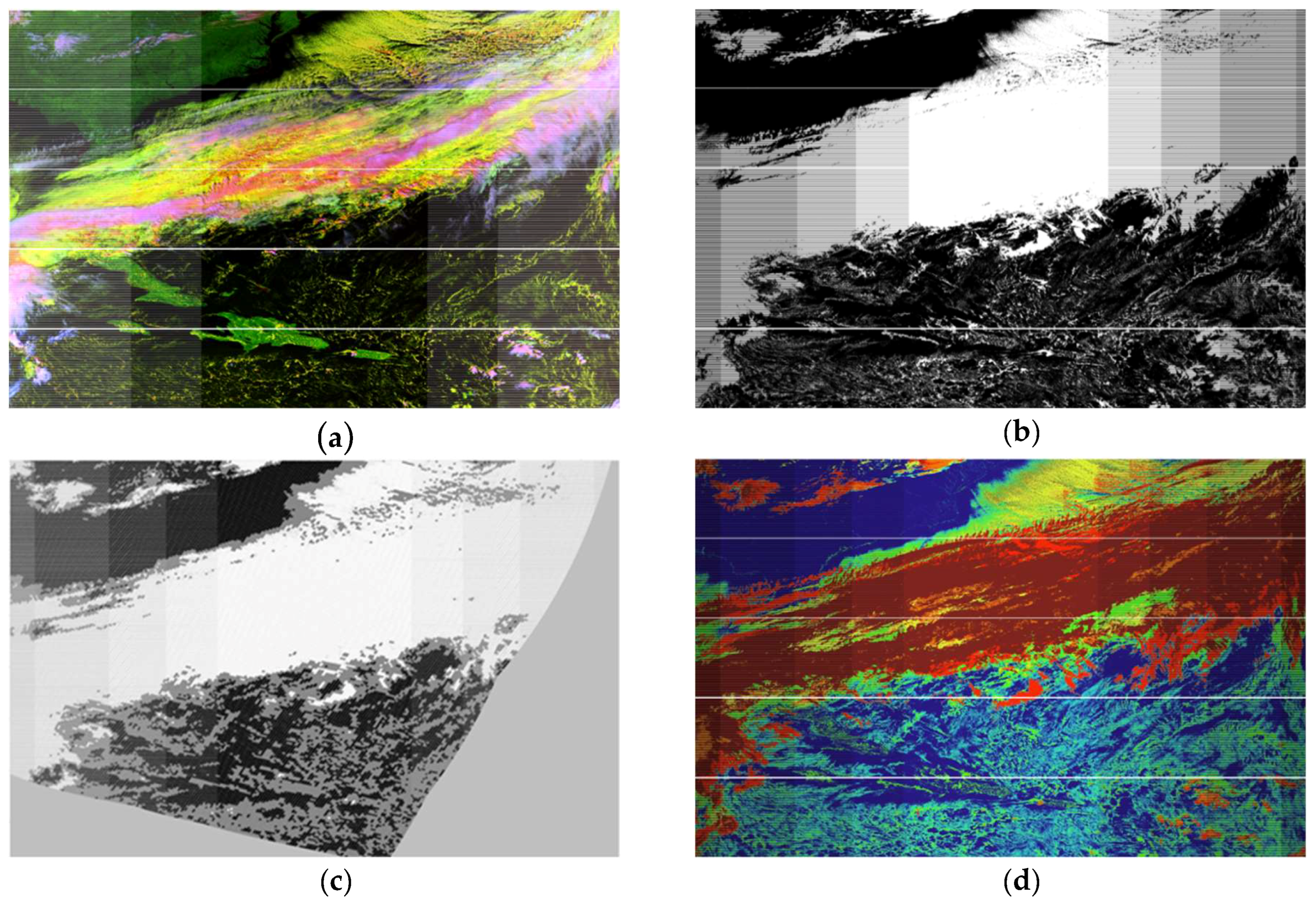
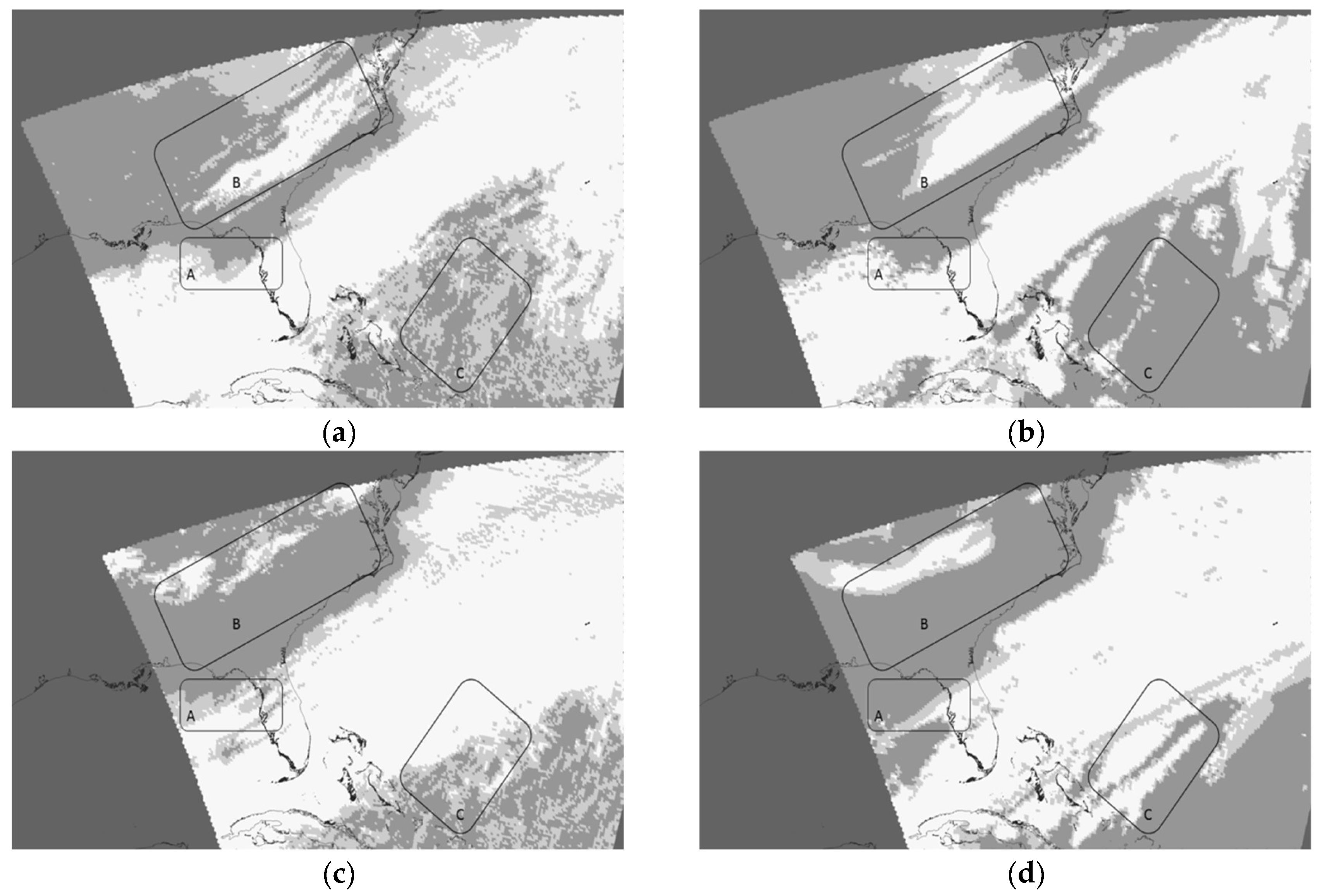
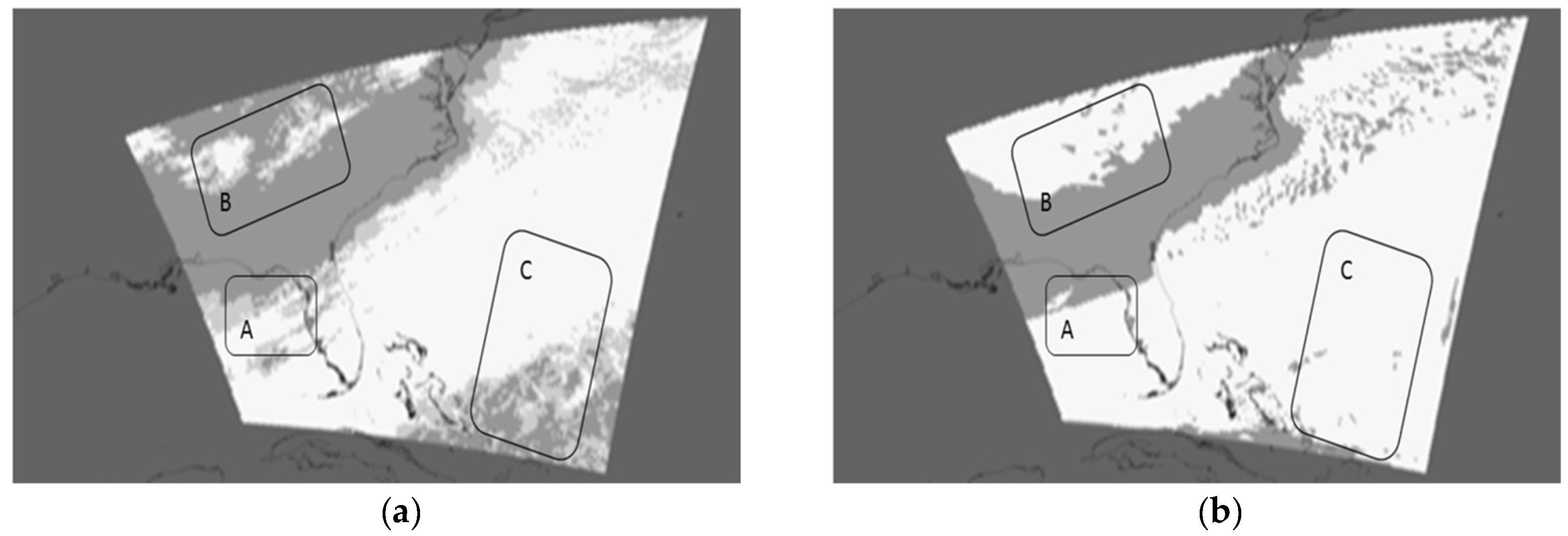
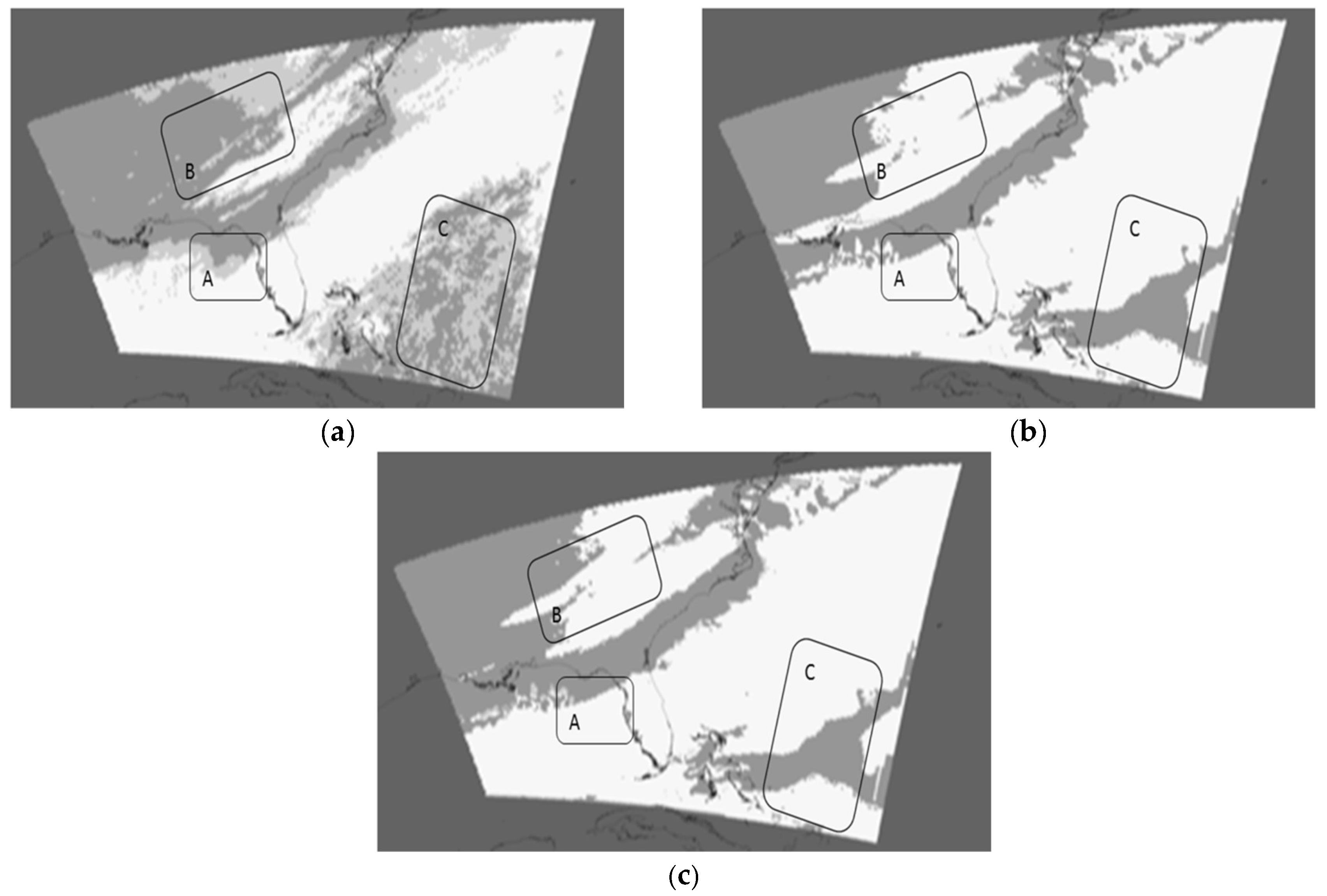
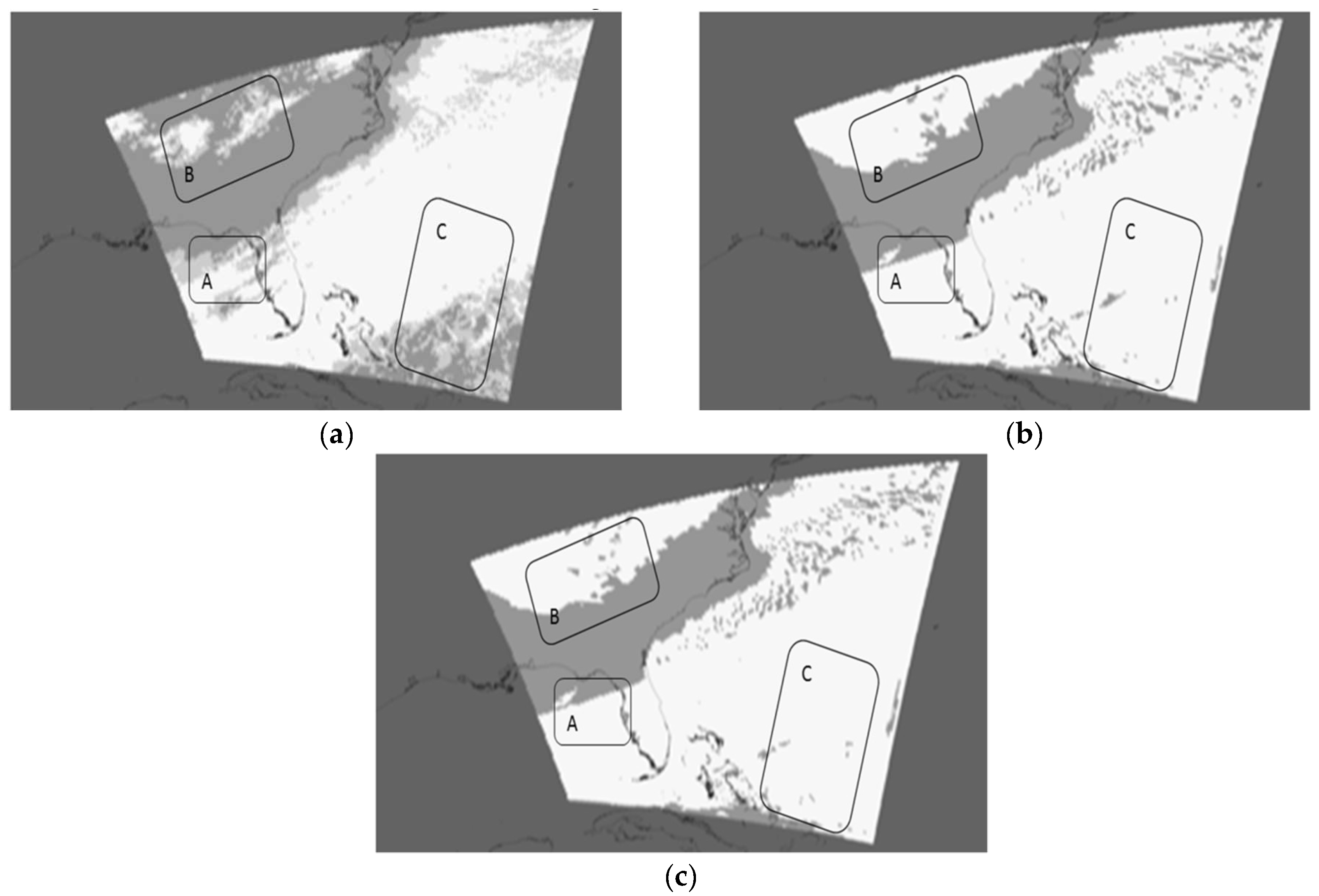
| Simulation Characteristics | Parameter Settings |
|---|---|
| Period of simulation | Variable (e.g., 6, 12, and 24 h case 1800 UTC 18–19 November 2014) |
| Meteorological data | NAM reanalysis (ds609.0) |
| Horizontal spatial resolution | 12 km |
| Time step | 60 s |
| Number of vertical levels | 42 |
| Top pressure in profiles | 10 hPa |
| Shortwave radiation | Dudhia scheme |
| Longwave radiation | RRTM scheme |
| Surface boundary layer | Monin-Obukhov similarity |
| Land surface layer | USGS |
| Planetary boundary layer | YSU |
| Cloud microphysics | Milbrandt 2-mom |
| Cumulus physics | Grell-Devenyi |
| Demonstrated model spin-up | 6 h |
| Bin Number | CCftruth Interval (%) | Performance Metric | CCfNAM | CCftruth |
|---|---|---|---|---|
| 1 | 0 ≤ CCftruth < 10 | count | 12,689 | |
| mean (%) | 8.0 | 1.6 | ||
| standard deviation (%) | 24.6 | 2.7 | ||
| 2 | 10 ≤ CCftruth < 20 | count | 2365 | |
| mean (%) | 8.9 | 14.5 | ||
| standard deviation (%) | 25.8 | 2.8 | ||
| 3 | 20 ≤ CCftruth < 30 | count | 1342 | |
| mean (%) | 9.8 | 24.6 | ||
| standard deviation (%) | 26.5 | 2.8 | ||
| 4 | 30 ≤ CCftruth < 40 | count | 731 | |
| mean (%) | 10.1 | 34.5 | ||
| standard deviation (%) | 25.6 | 2.9 | ||
| 5 | 40 ≤ CCftruth < 50 | count | 388 | |
| mean (%) | 16.7 | 44.4 | ||
| standard deviation. (%) | 33.2 | 2.8 | ||
| 6 | 50 ≤ CCftruth < 60 | count | 238 | |
| mean (%) | 18.9 | 54.6 | ||
| standard deviation (%) | 34.4 | 2.8 | ||
| 7 | 60 ≤ CCftruth < 70 | count | 165 | |
| mean (%) | 26.8 | 64.5 | ||
| standard deviation (%). | 39.7 | 2.9 | ||
| 8 | 70 ≤ CCftruth < 80 | count | 90 | |
| mean (%) | 28.4 | 74.0 | ||
| standard deviation (%) | 38.6 | 2.7 | ||
| 9 | 80 ≤ CCftruth < 90 | count | 63 | |
| mean (%) | 30.5 | 84.9 | ||
| standard deviation (%) | 42.0 | 3.0 | ||
| 10 | 90 ≤ CCftruth < 100 | count | 71 | |
| mean (%) | 38.0 | 95.5 | ||
| standard deviation (%) | 46.7 | 2.8 | ||
| 11 | CCftruth = 100 | count | 71 | |
| mean (%) | 63.1 | 100.0 | ||
| standard deviation (%) | 43.5 | 0.0 |
| CCf Interval (%) | CCfWRF Counts | CCftruth Counts |
|---|---|---|
| 0 ≤ CCf ≤ 10 | 9496 | 11,011 |
| 10 < CCf ≤ 20 | 67 | 1646 |
| 20 < CCf ≤ 30 | 23 | 1059 |
| 30 < CCf ≤ 40 | 16 | 781 |
| 40 < CCf ≤ 50 | 20 | 709 |
| 50 < CCf ≤ 60 | 6 | 655 |
| 60 < CCf ≤ 70 | 12 | 649 |
| 70 < CCf ≤ 80 | 11 | 774 |
| 80 < CCf ≤ 90 | 4 | 961 |
| 90 < CCf ≤ 100 | 21,672 | 13,082 |
| Total | 31,327 | 31,327 |
© 2019 by the authors. Licensee MDPI, Basel, Switzerland. This article is an open access article distributed under the terms and conditions of the Creative Commons Attribution (CC BY) license (http://creativecommons.org/licenses/by/4.0/).
Share and Cite
Hutchison, K.D.; Iisager, B.D.; Dipu, S.; Jiang, X.; Quaas, J.; Markwardt, R. A Methodology for Verifying Cloud Forecasts with VIIRS Imagery and Derived Cloud Products—A WRF Case Study. Atmosphere 2019, 10, 521. https://doi.org/10.3390/atmos10090521
Hutchison KD, Iisager BD, Dipu S, Jiang X, Quaas J, Markwardt R. A Methodology for Verifying Cloud Forecasts with VIIRS Imagery and Derived Cloud Products—A WRF Case Study. Atmosphere. 2019; 10(9):521. https://doi.org/10.3390/atmos10090521
Chicago/Turabian StyleHutchison, Keith D., Barbara D. Iisager, Sudhakar Dipu, Xiaoyan Jiang, Johannes Quaas, and Randy Markwardt. 2019. "A Methodology for Verifying Cloud Forecasts with VIIRS Imagery and Derived Cloud Products—A WRF Case Study" Atmosphere 10, no. 9: 521. https://doi.org/10.3390/atmos10090521
APA StyleHutchison, K. D., Iisager, B. D., Dipu, S., Jiang, X., Quaas, J., & Markwardt, R. (2019). A Methodology for Verifying Cloud Forecasts with VIIRS Imagery and Derived Cloud Products—A WRF Case Study. Atmosphere, 10(9), 521. https://doi.org/10.3390/atmos10090521






